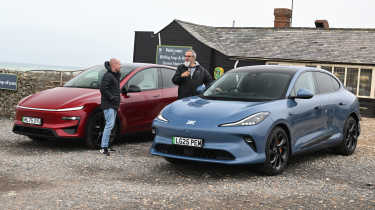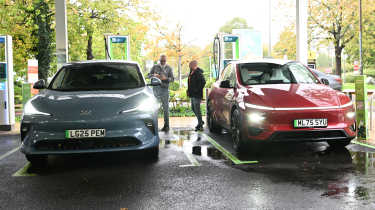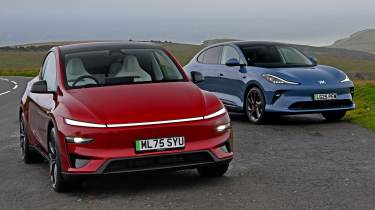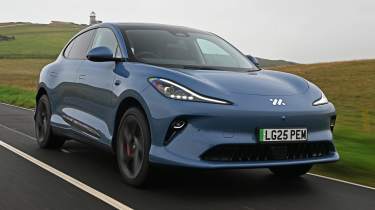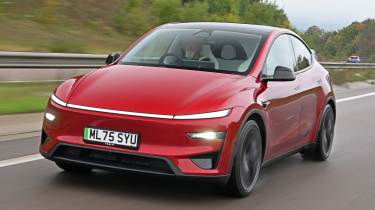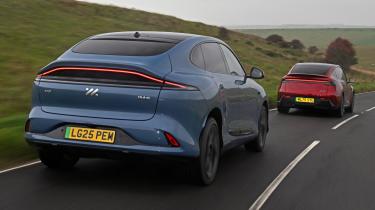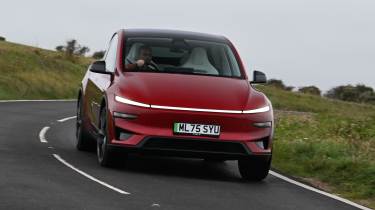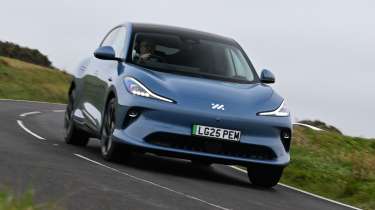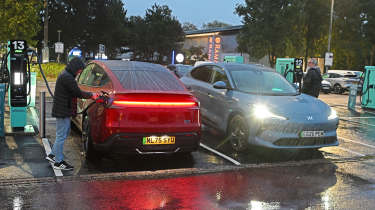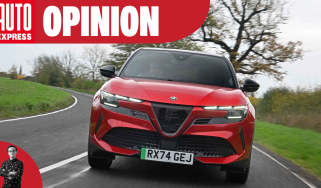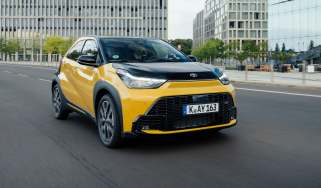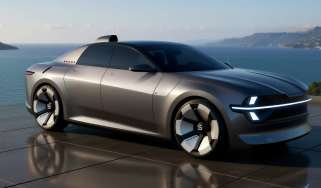MG IM6 vs Tesla Model Y: has Tesla’s popular SUV finally met its match?
Should Tesla be worried by MG’s arrival in premium territory? Our M25 trip sets the scene for head-to-head
Over the past year or so, the idea of getting behind the wheel of a Tesla has left me wanting to wear a paper bag over my head. The views of the company’s CEO Elon Musk have left a bitter taste for many people, me included; it’s why there’s been a lucrative market for “I bought this before Elon went mad” bumper stickers, as owners try to distance themselves from his political leanings.
Yet here I am, pounding along a soaking M25 in a Model Y Performance (minus a paper bag), sampling the updated flagship model for the first time. And you know what? It’s a shame that Tesla is so inextricably tied to its boss, because putting politics aside, the Model 3 saloon and Model Y SUV – now the only new Teslas sold in the UK – continue to set a benchmark that all other electric vehicles must be judged against.
And that’s exactly what we’re doing on a wet and windy weekday morning, because hot on the Tesla’s tail is an all-new contender that follows a very similar template to the Model Y.
The MG IM6 is a car that breaks new ground for MG Motor, the Chinese firm that rose from the ashes of the British car maker that disappeared in 2005. Although the company is further along the path to electrification than many other firms, up until now the bulk of its model range has focused on value for money over anything like style or performance. But the IM6 is aiming to change that, and it meets the Tesla Model Y head-on in terms of price, technology, performance and charging – even its jelly mould shape looks a bit like a Model Y.
With all of this in mind, it only seemed logical to pitch the two head to head. So my colleague Alex Ingram and I lined up both cars for a road trip to find out if MG has really built a ‘Tesla killer’.
Used - available now

2020 Volkswagen
Golf Estate
14,321 milesAutomaticDiesel2.0L
Cash £20,300
2026 BMW
4 Series
41,945 milesAutomaticPetrol2.0L
Cash £23,800
2021 Volvo
XC40
32,000 milesManualDiesel2.0L
Cash £19,500
2025 Vauxhall
Astra
19,301 milesManualPetrol1.2L
Cash £13,600After charging both models to 100 per cent the night before, we headed to South Mimms services in Hertfordshire on the M25 as our starting point, me in the MG, Alex in the Tesla, with a plan to slog halfway around London’s orbital motorway before heading south to Beachy Head and Eastbourne in East Sussex. With 300-plus miles of range on offer in both cars, there wouldn’t be any issues with range anxiety, plus we’d get plenty of time to find out their plus and minus points.
With the two cars parked side-by-side at South Mimms’ Applegreen EV chargers, the similarities between them are obvious. They’re both designed to cut through the air as efficiently as possible to help maximise range, so low noses and coupé-style rooflines are the order of the day.
But the IM6’s bulbous lines mean it looks a little more awkward from the front than the facelifted Tesla, with its Cybertruck-style lightbar that stretches across the full width of the nose. The MG’s rear end has a passing resemblance to that of an Aston Martin DBX, too, with a duck-tail boot lip that is highlighted by the contour of an LED lightbar. In contrast, the Tesla’s uncluttered rear makes the hidden lighting that runs the width of the tailgate a focal point, with its gentle glow reflecting off the plastic trim below.
One thing’s obvious, and that’s the size of the IM6 when compared with the Model Y. It’s bigger in every dimension, so it’s a good job there’s a suite of 360-degree cameras on board, because the swoopy lines do visibility no favours, especially out the back.
MG quotes a range of 313 miles for the IM6 Performance under test conditions, compared with 360 miles officially for the Model Y Performance. But a full charge of the IM6’s 100kWh battery only garnered a maximum of 298 miles once at 100 per cent capacity. Charging is quick, though, with a maximum rate of 350kW possible, meaning the car’s pack can go from 10-80 per cent capacity in 17 minutes.
In comparison, the Model Y’s fastest charge rate from Tesla’s Supercharger network is 250kW, so a zero to 80 per cent charge takes 27 minutes. Our Performance model came up nearly 60 miles short of its official figure, too, with only 301 miles of range showing before setting off. The American manufacturer doesn’t quote a battery capacity for its cars, so the proof in range capability for both models is in the back-to-back driving.
Having delivered the IM6 to South Mimms, I already had a fair idea of how MG’s new electric SUV performs, so it was my turn in the Model Y for the trudge clockwise around the M25. Dreary, grey weather, gantry-enforced speed limits and numerous lane hoggers oblivious to their surroundings really suck the life out of driving, so it’s no wonder that London’s ring road is one of the most hated stretches of tarmac in the UK.
Fortunately the Tesla is quiet and refined, much like the MG was on the way to our start, although lower-profile tyres and a stiffer suspension set-up mean it’s not the most settled version of the Model Y. However, it’s hardly harsh at 70mph.
Moving to country roads on the route to Beachy Head, and I’m happier to be in the Tesla than in the IM6. The MG is a hefty machine, with its kerbweight of 2.4 tonnes being nearly 400kg more than the Tesla’s, and its suspension doesn’t cope as well with the kind of bumpy roads that are standard across the UK. Vague steering also puts a dampener on things – but while the Tesla is better, there’s still an artificial edge to it that makes it feel more like you’re piloting a video game than an actual car down actual roads.
One thing neither car is lacking is straight-line pace, hence their Performance names. The Tesla offers a substantial 453bhp from its dual-motor set-up, which is plenty to work with in everyday driving, but the IM6 eclipses this with a gargantuan 742bhp. Yet despite its power advantage, both cars record the same 0-62mph time of 3.5 seconds – the IM6’s weight clearly coming into play again – while the MG feels quite unruly as the chassis and powertrain struggle to cope.
Not that a vast power output is conducive to efficiency testing, which is one of the main reasons why we’ve lined these two up in the first place. One highlight of the IM6 is the assorted drive modes that can adjust the car’s set-up from sporty to ultra-efficient.
Just switching from the snappy Sport mode to the more measured Comfort setting adds around 20 miles to a full charge, while the swap from Comfort to the even more restrained Eco preset adds another 15 miles, according to the onboard computer.
‘Super Eco’ can also be activated via the second screen. Select this, and the electronics do everything bar put the car into limp mode to save energy. The climate control system shuts down, the touchscreens go dark, audio is switched off and most of the ADAS electronic systems are deactivated. This is good for adding around 10 miles of range, although it seems a bit of a desperate measure when the south-east of England is pretty well catered for when it comes to fast charging.
While the Model Y is clearly more at home on country roads than the IM6, the MG is a better performer on the streets of Eastbourne. A softer suspension set-up than the Tesla’s helps it to deliver a more refined experience, and the silence of the interior only adds to the sensation of comfort.
Rear-wheel steering also boosts the MG’s manoeuvrability, with the car delivering a 10.18-metre turning circle that’s tighter than what’s on offer in most superminis.
Both electric SUVs offer good interior space, but their minimalist design will be frustrating for some people. While Tesla puts all of its technology – including the drive selector – on the vast 16-inch touchscreen, the MG has two displays that offer different functions, but the multi-menu layout can be distracting to use. They both also have minimalist steering wheels, with small rocker switch controls that only unlock the secrets of their function when you use them. We think that adding some small labels to indicate what they control would make the experience all the better.
Our final leg saw me back in the IM6 as we headed to Gridserve’s electric forecourt at Gatwick Airport in West Sussex for a final recharge before heading for home. More miles in the MG confirmed that cruising comfort is its forte, with suspension that soaks up big bumps well, and only a slight patter to the ride over smaller imperfections.
Again, the flex of having 742bhp under your right foot seems excessive in such a big, heavy EV. Once we crunched the numbers, we saw that this combination didn’t help the IM6’s efficiency figures, either. Our trip was very revealing – read on for our comprehensive breakdown of each model’s pros and cons.
Did you know you can sell your car through Auto Express? We’ll help you get a great price and find a great deal on a new car, too.
MG IM6
| Model: | MG IM6 Performance |
| Price: | £50,995 |
| Powertrain: | 100kWh battery, 2x e-motors, 742bhp |
| 0-62mph: | 3.5 seconds |
| Test efficiency: | 2.5 miles/kWh |
| Official range: | 313 miles |
| Annual VED: | £620 |
The latest addition to the MG Motors line-up is sold in other territories under the IM Motors banner, hence the car’s lack of MG badges, with just one reference to MG on the bootlid. The whole IM Motors project is a product of a joint venture between MG parent firm SAIC and technology giants Alibaba and Zhangjiang, while the IM6 uses the same platform as the IM5 saloon.
It only comes with the larger 100kWh battery found in the IM5, but there is a choice of two power outputs. We’re testing the more powerful £50,995 Performance model here, while the car in our pictures is the Launch Edition, which adds adjustable dampers and air suspension to the standard equipment list for £2,000 extra.
Tester’s notes
We’re getting used to car makers reinventing the door handle, whether it’s Tesla and its pop-out levers or the ‘one-touch’ handles favoured by Lexus, but MG has created something different again.
Unlock the car and the flush handles sprout from the doors, as they do on a number of other cars, but rather than pulling on them to open, you simply stick your hand in the slot and a sensor pops the door latch. Then you gently pull the handle to open. Exiting is via a push button on the side of the armrest, which is a little hidden.
I like that you can customise your own shortcut page on the touchscreen and assign your own shortcut to the right-hand steering wheel control. The ADAS menu is the obvious choice to put there.
But it’s a bit of a ritual to set up the safety systems as you like them, because once you’ve selected whether you want a speed-limit warning and lane centring the way you like them, you then have to hit two more confirmation buttons to complete the process. It’s not as simple as some rival set-ups that just require a single button press.
Tesla Model Y
| Model: | Tesla Model Y Performance |
| Price: | £61,990 |
| Powertrain: | 84kWh battery, 2x e-motors, 453bhp |
| 0-62mph: | 3.5 seconds |
| Test efficiency: | 3.3 miles/kWh |
| Official range: | 360 miles |
| Annual VED: | £620 |
Tesla has established itself as one of the market leaders of electric cars, and in many respects, that reputation is entirely deserved. Strong powertrains, impressive efficiency and the US manufacturer’s exceptional Supercharger network – enough to be a deal-breaker in itself for some buyers – set Tesla’s cars apart from much of the competition.
A facelift has mainly focused on areas of the Model Y which were traditionally weaker points – most noticeably the ride, handling and refinement – yet it has also managed to deliver some marginal gains in areas where the car was already so strong. As with the MG, it’s the Performance model we’re driving here; but at £61,990, it’s almost £11,000 more expensive than its Chinese rival, before options.
Tester’s notes
It feels Tesla’s Full Self Driving autonomous tech has forever been just out of reach for UK buyers. While it’s been trialled in North America for some time, it finally looks like we’ll be able to benefit from the car’s ability to navigate itself to a chosen destination, with owners also getting the ability to “summon” their car; calling it from a mobile app to meet them at a specific destination.
Trials in the UK have started, and while a precise date hasn’t been confirmed, a Tesla spokesperson told me to expect a launch in 2026. There are several ways that Tesla can claim to be an industry leader, but we believe that one of the most overlooked is in the quality of its powertrain calibration.
I’m not normally a fan of electric vehicles’ one-pedal driving systems (I prefer a more petrol-style level of deceleration), but the Model Y’s set-up is so good that I found myself using it all the time. It’s at its best in stop/start traffic, where the system can bring the car to a halt more smoothly than almost any other car I’ve driven.
Head-to-head
Tech highlights
As the hottest models in their respective ranges, power was never going to be in short supply with this pair. The Tesla Model Y Performance has a healthy 453bhp, but the IM6’s on-paper figures are a staggering 742bhp and 802Nm of torque. But, at 2,410kg, the IM6’s official kerbweight is 377kg more than its rival’s. A four-wheel steer system makes the IM6 more manoeuvrable than its 4.9-metre length suggests.
On the road
Those differences in stats translate to very similar real-world speed. Officially, the IM6 and Model Y have identical 0-62mph times, but we found the MG has a performance advantage once rolling. At low speeds, it struggles to deploy its traction, while the Model Y’s powertrain feels much more sophisticated. The same goes for the suspension; the Model Y’s body control is more tied-down than the vague IM6’s.
Price and running
On paper, the Tesla manages to drive further than the IM6 while using much less energy, and that’s translated into the real world, too. The Performance versions are certainly powerful, but lesser models are still quick enough while travelling even further on a charge. Cheaper Model Ys hold their value better than the Performance, too. The Performance version of the IM6 is much cheaper to buy than the hot Tesla.
Practicality
Both of these cars are very spacious. The Tesla’s cabin feels more open and airy, but the IM6’s soft rear bench with reclining backrests offers up vast legroom. At 665 litres, its boot is enormous, too, but the Tesla’s space is similarly huge and benefits from an even deeper underfloor storage area. Up front, the Model Y’s frunk is fitted with a drain plug, so it can be easily rinsed out after carrying damp or muddy items.
Safety
The MG and Tesla each passed Euro NCAP's safety tests with flying colours. The MG achieved a five-star rating in 2025 and the Model Y scored five in 2022 – the Tesla’s Adult Occupant Protection and Safety Assist category scores were the highest of any car tested that year. We found the lane-keep assist tech in both cars to be over-zealous, and the Model Y’s tiny, red blind-spot warning indicator is too subtle.
Ownership
Owners say that Teslas are better to live with than MGs - and by quite some margin. Of the 31 brands featured in our 2025 Driver Power satisfaction survey, Tesla finished 11th overall, while MG came last. The Tesla gets four years’ free breakdown cover to the MG’s 12 months, too. However, while the Tesla’s warranty runs for the same time as its breakdown cover, the IM6 gets an impressive seven-year package.
Verdict
Winner: Tesla Model Y Performance
In this contest, the Model Y Performance proves itself to be a superbly rounded fast SUV. In terms of powertrain quality, chassis sophistication, efficiency and in-car tech, it’s got too much for the MG, while it’s a close match for the IM6’s strongest points, which are straight-line speed and practicality.
The trouble with the Performance version is that because the rest of the Model Y range is so strong, it’s harder to justify – especially when it costs more than any of its range mates. That’s why it loses half a star compared with the cheaper options in the line-up, all of which would get our nod over the IM6.
Runner-up: MG IM6 Performance
If going fast in a straight line is where you get your SUV kicks, then look no further than the MG IM6 Performance. For the cash, it offers incredible speed, and backs that up with a roomy, comfortable cabin.
Beyond these very strong points, the IM6 doesn’t quite hit the mark in the way that many other cheaper MGs have previously, though. The chassis struggles to live with the motors’ huge output, energy efficiency is at best underwhelming, and the in-car technology isn’t as slick as the Tesla’s set-up. Although there are areas that seem tempting, there’s certainly room for improvement with the IM6.
Prices and specs
| Model tested | MG IM6 Performance | Tesla Model Y Performance |
| Price from/price of model tested | £47,995/£50,995 | £44,990/£61,990 |
| Powertrain and performance | ||
| Powertrain | 2x electric motors | 2x electric motors |
| Power | 741bhp | 453bhp |
| Torque | 802Nm | 742Nm (est) |
| Transmission | Single-speed auto/4WD | Single-speed auto/4WD |
| 0-62mph/top speed | 3.5 seconds/148mph | 3.5 seconds/155mph |
| Battery capacity/usable | 100/96.5kWh | 84kWh/N/A |
| Official range | 313 miles | 360 miles |
| Test efficiency/range | 2.5mi/kWh/241 miles | 3.3 mi/kWh/274 miles |
| Max. charging | 350kW (10-80% in 17 mins) | 250kW (0-80% in 27 mins) |
| Dimensions | ||
| Length/wheelbase | 4,904/2,950mm | 4,796/2,890mm |
| Width/height | 1,988/1,669mm | 1,982/1,611mm |
| Rear kneeroom | 660-875mm | 680-989mm |
| Rear headroom/elbow room | 980/1,530mm | 948/1,455mm |
| Boot space (front/seats up/down) | 32/665/1,621 litres | 88/845 (to roof)/2,022 litres |
| Boot length/width | 1,000/1,005mm | 1,091/945mm |
| Boot lip height | 685mm (access mode) | 600mm |
| Kerbweight/payload/towing weight | 2,355/455/2,000kg | 2,033/0/1,600kg |
| Turning circle | 10.18 metres | 12.1 metres |
| Costs/ownership | ||
| Residual value (after 3yrs/36,000 miles) | £24,223/47.5% | £30,387/49.0% |
| Depreciation | £26,772 | £31,603 |
| Insurance group/AA.com quote/VED | 50/N/A/£620 | 47/£1,004/£620 |
| Three-year service cost | TBC | £0 |
| Annual tax liability std/higher rate | £306/£611 | £371/£743 |
| Annual electricity cost (12,000 miles) | £1,029 | £1,092 |
| Basic warranty (miles)/recovery | 7yrs (80,000)/1yr | 4yrs (unlimited)/4yrs |
| Driver Power manufacturer position | 31st | 11th |
| NCAP Adult/child/ped./assist/stars | 90/85/83/87/5 _ (2025) | 97/87/82/98/5 _ (2022) |
| Equipment | ||
| Metallic paint/wheel size | £545/21 inches | £1,300-£2,600/21 inches |
| Parking sensors/camera | Front, rear & side/360 | Front, rear & side/360 |
| Spare wheel/Isofix points | Repair kit/two | Repair kit/two |
| Keyless entry & go/powered tailgate | Yes/yes | Yes/yes |
| Leather/heated seats/steering wheel | Artificial/front & rear/yes | Part artificial/front & rear/yes |
| Screen size/digital dashboard | 10.5 inches/26.3 inches | 16.0 inches/no |
| Climate control/panoramic sunroof | Two-zone/yes | Two-zone/yes |
| USBs/wireless charging/heat pump | Three/yes/yes | Four/two/yes |
| Wireless Apple CarPlay/Android Auto | Yes/yes | No/no |
| Blind-spot warning/head-up display | Yes/no | Yes/no |
| Adaptive cruise control/steering assist | Yes/yes | Yes/yes |
What we would choose
MG IM6
Of the four exterior colours in which to finish the IM6, all look a little uninspiring to our eyes, but the option of a cream-and-brown interior certainly adds some visual interest – even if it might not be the most practical choice for family life.
Tesla Model Y
Tesla’s Autopilot and supervised Full Self-Driving driver-assist systems are pricey extras at £3,400 and £6,800 respectively. Exterior colour choices range from £1,300 to £2,600 beyond the no-cost Stealth Grey.
Looking for your next car? You can now search our nationwide dealer network for a choice of great cars on offer right now with new, used and leasing deals to choose from...

